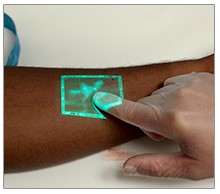Common vascular access challenges in radiology:
- Limited viable patient access sites due to previous IV’s and procedures.
- Increased risk of blowing a vein due to use of power injectors with high pressure and flow rates.
- If a vein is “blown” when injecting a contrast/nuclear medicine agent, the result can be a safety risk from exposure to caustic materials.
Procedure delays can be very costly over time. The average diagnostic imaging cost for procedures requiring IV placement is $4336 per hour. Inefficiencies in scheduling can have a direct impact to your bottom line.
VeinViewer has been proven to:
- Increase first stick success by up to 100%
- Decrease PICC lines placed due to difficult venous access by greater than 30%
- Increase patient satisfaction by 100%
The Pre-, During- and Post-access (PDP) benefits provided by VeinViewer may help avoid common radiology pitfalls. VeinViewer’s ability to assess the catheter after placement, can potentially help avoid serious complications and preserve veins over time.
- VeinViewer’s TrueView accuracy provides an image you can trust.
- VeinViewer’s projected vein width displays with near perfect accuracy. Displayed vein width can greatly impact assessing catheter gauge prior to insertion.
- See peripheral veins up to 10 mm deep and blood patterns up to 15 mm deep providing more potential access sites.
- Locate valves and bifurcations which aids in decision making for the point of insertion.
- Assess IV patency during and after placement through visualization of fluid flushing and detection of a hematoma as it forms.
- Potentially avoid an infiltration or extravasation.
To learn more about VeinViewer’s clinical benefits Pre-, During- and Post-access in Radiology, speak to a Christie expert today by calling 877 SEE VEIN.




